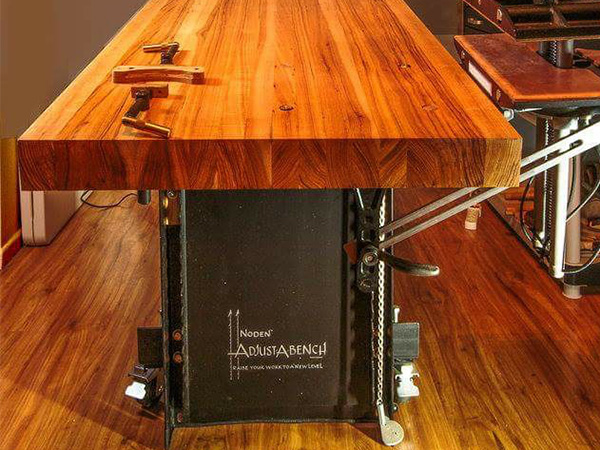
How often does it register with you that your workbench is the wrong height? Sometimes you need it to be lower, so you don’t have to stand on a box to apply clamps to an assembly. Other times, you need it to be higher — when routing dovetails on a 4-foot-long chest-front, for example. And think about how handy it would be to have an outfeed table during a band-saw operation. Or a bench to support a long workpiece you are attacking on the drill press.
A Noden Adjust-A-Bench is just what you need. (It is certainly what I need!) It is the invention of furnituremaker Geoffrey Noden, who felt the need in his own shop, and had the know-how to design a sound, foolproof adjustable-height leg assembly.
If mounted on the Noden leg assemblies, a benchtop can be raised and lowered through a 15-inch adjustment range. The legs are strong enough to withstand all the pounding, pushing, and pulling your woodworking can deliver. What is unique is that you can drop it to mid-thigh height when an assembly table is what you need, then jack it up above elbow height when a higher-than-usual work surface is useful. The ratchet adjustment mechanism provides a stop every 1 1/2 inches. Optional casters provide a means of fine adjustment between ratchet stops.
For the last several weeks, I’ve been using Noden’s own bench, which he lent me right off the floor of the Philadelphia Furniture Show in April. It has been great for operations I usually do at my 4-foot-tall router bench. Loved having it when I assembled the case for a chest of drawers (haven’t gotten that low assembly table built yet). And I sure would like to have the casters so it would be easier to move around the shop. Even though this particular bench lacks a vise and has a top I’m leery of marring, it is handy and practical.
The Adjust-A-Bench consists of a pair of powder-coated metal leg assemblies. You supply the wooden rails and a benchtop. Each assembly consists of two nesting trays with a ratcheting mechanism. Together the pair weigh 78 pounds.
To raise the benchtop, you simply lift it. A latch in the ratchet prevents the bench from dropping. To lower the benchtop, you step on a foot pedal and lift slightly. The pedal disengages the latch and allows the benchtop to be lowered. (If you step on the pedal inadvertently, the benchtop won’t drop.) Adjust the bench one end at a time or, if you have a helper, both ends simultaneously. Set it level or at an angle.





